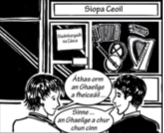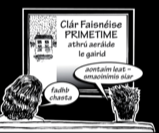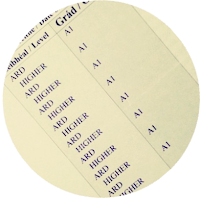The oral is worth 40% of both the Higher and Ordinary exam. The Sraiths are a vital component, and if you are well prepared, will settle you before the general comhrá. There are 20 Sraith Pictiúrs, and the (admittedly tempting) task of learning all of them off by heart is a waste of valuable time and energy. A much smarter and efficient way of prepping for this section is by using condensed notes, for key vocab and phrases. A lot of the vocab overlaps, minimising the amount of material students must cover. Consistently looking over these will enable you to gain confidence in forming sentences and attacking any sraith the examiner might throw at you.
You may also like: Can I choose the poem I read in the Oral examination?
How to Approach:
Practise describing the sequences out loud, and ensure you are confident with pronunciation. Use simple, clear, accurate sentences. Doing this repeatedly will again build your confidence and your fluency – the key element your examiner will be looking for.
With each sraith, focus on the specific vocab, a few questions (you will have to ask the examiner three in your oral, as well as answering their three) and ideally a seanfhocal. These are old Irish sayings or idioms, and are beloved by examiners everywhere. I’ve included at least one per sraith, at the end in quotes. (See the full list for the translation of each.) The following phrase is a good way to introduce them:
Mar a deir an seanfhocal, “_____” {As the old saying goes, “_____”}
Others ways to really impress/bag an A1 are by demonstrating tricky grammar points such as:
- Indirect Speech (Don’t use Tá/Bhí!):
Dúirt Síle go raibh áthas uirthi {Síle said that she was happy}
- Saor Briathar (When you don’t know who is doing the action)
Rinneadh a lán damáiste {A lot of damage was done}
- Tuiseal Ginideach (of)
Feminine: teanga ársa na Gaeilge {the ancient language of Irish}
Masculine: hata an fhir {the hat of the man}
Note that there is only one “the” – you cannot say an teanga ársa na Gaeilge! This is probably the trickiest grammar point, but if you can use it even once you’ll be setting yourself up well.
The really good news is you don’t have to fully understand these to show them. I’ve highlighted them in the full upcoming version of the Irish guide, so simply pick a few and throw them in (correctly!). I’ve also underlined a few things to look out for on the pronunciation front. If in doubt, ask a teacher and write the word down phonetically in your notes. Another quick tip – you can describe the scenes in whichever tense you chose, but most find it easiest to use the past, and to tell them like a story. Also, using names that avoid seimhiús makes life a bit simpler – Oisín, Áine, Liam & Úna will be your best friends.
Ádh Mór Ort, a Chara!
6) An Ghaeilge – seoid luachmhar agus cuid dár gcultúr

fógrá i nGaeilge ar dhoras an tsiopa ceoil
úirlísí ceoil – cláirseach, consairtín, bosca ceoil, bainseó, bodhrán
Dúirt Síle go raibh áthas uirthi an Ghaeilge a fheiceáil sa chathair
Cheap Liam go raibh dualgas [duty] orthu teanga ársa na Gaeilge a chur chun cinn
Chuardaigh siad [They searched] eolas faoin nGaeltacht ar an idirlíon
Tháinig siad ar leathanach “Fb” faoi thuras chun na Gaeltachta
Bheartaigh said clárú don turas [They decided to register for the trip]
Chaith siad coicís [fortnight] i nGaeltacht Chonamara
Ar maidin, bhíodh ranganna cainte acu [They used to have conversation classes. This is the habitual past tense – very rare and very impressive!]
Bhain siad an-sult [enjoyment] as bheith labhairt na Gaeilge le chéile ar a suaimhneas [at their leisure]
eitpheil ar an trá
Chuaigh an t-am a chaith siad sa Ghaeltacht go mór i bhfeidhm orthu [The time they spent in the Gaeltacht really made an impact on them]
Bheartaigh siad iarracht a dhéanamh an Ghaeilge a chur chun cinn [promote]
Bhunaigh/D’eagraigh siad ciorcal cainte as Gaeilge
Tháinig slua mór chuig an gciorcal agus rinne gach duine an-iarracht an Ghaeilge a labhairt le chéile
“Is fearr Gaeilge bhriste ná Béarla cliste” an mana a bhí acu
ar a bealach [on her way] chun na scoile
Bhí súil aici go bhfeabhsófaí a cuid Gaeile de réir a chéile [She hoped her Irish would improve gradually]
Cheap S gurbh fhiú féachaint ar TG4 chun tacú [support] leis an nGaeilge
Ag deireadh na bliana, bhí Bronnadh na nDuaiseanna ar scoil
Bhronn an t-aoi-chainteoir [guest speaker] gradam speisialta ar Liam agus ar Shíle
Dúirt sí go ndearna an bheirt acu an-obair ag neartú na Gaeilge sa scoil agus sa cheantar
“Ní neart go cur le chéile” / “Beatha teanga í a labhairt” / “Tír gan teanga, tír gan anam”
– Cén sórt imeachtaí a bhí ar siúl sa Ghaeltacht?
– Conas a bhí an aimsir i bpictiúr a trí?
– Cad a bhí á dhéanamh ag na daltaí i bpictiúr a ceathair?
– Conas a mhothaigh an bheirt ag an deireadh?
10) Drochaimsir an Gheimhridh – Athrú Aeráide

clár faisnéise [documentary]
Bhí an t-ábhar athrú aeráide á phlé acu [discussing climate change]
Shíl Áine gur fhadhb chasta [complex problem] í
Smaoinigh siad siar ar an drochaimsir a bhí ann le déanaí [recently] – ar na tuilte [floods] agus na stoirmeacha uafásacha a rinne a lán damáiste do thithe agus go háirithe do na ceantair chósta [coastal areas]
Thit an-chuid sneachta an geimhreadh roimhe sin
Thit an teocht go dtí ocht gcéim faoin reophointe
Bhí an áit clúdaithe le brat tiubh sneachta [The place was covered with a thick blanket of snow]
Mar gheall ar an bhfuacht, reoigh na píobáin uisce [the water pipes froze] in an-chuid tithe agus phléasc siad [they burst]
na pluiméirí ag deisiú na bpíobán [the plumbers fixing the pipes]
Rinneadh a lán damáiste sna tithe
D’ardaigh an t-árachas tí agus bhí costais ollmhóra ar na húinéirí bochta [House insurance rose and there were huge costs for the poor owners]
gaoth láidir ag séideadh
Thir crann trasna an bhóthair anuas ar charr
an-dainséarach
Maraíodh daoine ar na bóithre dá bharr [People were killed on the roads as a result]
i mbád ag tarrtháil [saving] daoine ó na tuilte
Ní raibh an scéal mórán difriúíl i mBaile Átha Cliath [The story wasn’t much different in Dublin]
carranna sáite san uisce [cars immersed in the water]
Déanann truailliú [pollution] an-chuid damáiste don domhan agus go háirithe don tsraith ózóin – poll mór [big hole]
na cnapáin oighir sa Mhol Thuaidh [North Pole] ag leá [melting]
Má leánn an Mol Thuaidh beidh níos mó tuilte ann agus ardóidh léibhéal an uisce
Dúirt Pól le hÁine gur cheap sé go raibh an timpeallacht i mbaol [in danger]
Thug an clár PrimeTime ábhar machnaimh [food for thought] dóibh
“Ar scáth a chéile a mhairimid”
– I bpictiúr a haon, cad a bhí á phlé ar an gclár faisnéise PrimeTime?
– I bpictiúr a dó, cén teocht a bhí ann?
– Conas a bhí an aimsir i bpictiúr a ceathair?
– Cé mhéad duine a bhí sa bhád tarrthála bpictiúr a cúig?
|
|
 |
|
Leaving Cert Sample Answers and Notes
|



